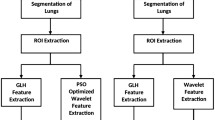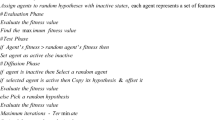Abstract
Feature selection in computer aided diagnosis is now becoming a challenging part in the classification of lung diseases. This is because, it needs to deliver results with improved accuracy and it also requires a greater number of features for analysis. The major demerit of widely utilized single-objective feature selection (FS) algorithm is that it proffers only a single optimum solution for a feature set. Here, a hybridized multi-objective particle swarm optimization with a local Tabu search (MOPSO-TS) algorithm is proposed to overcome the above demerit of the traditional single objective algorithm by producing a bag of optimum solutions which trade disparate objectives amongst themselves. The work is validated against a feature set which consists of GLCM features, shape features and GLRLM (gray-level run length matrix) extracted from lung chest tomography (CT) images. Classification is done using k-nearest neighbor with class probability and normal distribution (ND). The proposed FS method’s performance is analyzed against widely used bio-inspired FS methods such as Firefly, Particle Swarm Optimization along with Bee Colony Optimization algorithms. The numerical analysis of this model indicates that the proposed hybrid FS algorithm achieves improved performance compared to a single objective optimization algorithm in respect of specificity, accuracy, F-score, precision, sensitivity and error rate. The proposed algorithm obtains the result of 90.588% in both and specificity accuracy rate, (77.143) precision, 87.667 sensitivity rate and error rate of 0.1 which are higher on considering the other prevailing methodologies






Similar content being viewed by others
Explore related subjects
Discover the latest articles, news and stories from top researchers in related subjects.References
Adegoke BO (2014) Review of feature selection methods in medical image processing. IOSR J Eng 4:01–05. https://doi.org/10.9790/3021-04140105
Aha DW, Bankert RL (1996) A comparative evaluation of sequential feature selection algorithms. In: Fisher D, Lenz HJ (eds) Learning from data. Lecture notes in statistics. Springer, New York, pp 199–206
Anthimopoulos M, Christodoulidis S, Ebner L, Christe A, Mougiakakou S (2016) Lung pattern classification for interstitial lung diseases using a deep convolutional neural network. IEEE Trans Med Imaging 35(5):1207–1216. https://doi.org/10.1109/TMI.2016.2535865
Banati H, Bajaj M (2011) Fire fly based feature selection approach. Int J Comput Sci Issues 8(4):473–479
Bing X, Mengjie Z, Browne WN (2013) Particle swarm optimization for feature selection in classification: a multi-objective approach. IEEE Trans Cybern 43(6):1656–1671. https://doi.org/10.1109/TSMCB.2012.2227469
Bray F, Ferlay J, Soerjomataram I, Siegel RL, Torre LA, Jemal A (2018) Global cancer statistics 2018: GLOBOCAN estimates of incidence and mortality worldwide for 36 cancers in 185 countries. CA Cancer J Clin 68:394–424. https://doi.org/10.3322/caac.21492
Chang Y, Kim N, Lee Y, Lim J, Seo J, Lee YK (2012) Fast and efficient lung disease classification using hierarchical one-against-all support vector machine and cost-sensitive feature selection. Comput Biol Med 42(12):1157–1164. https://doi.org/10.1016/j.compbiomed.2012.10.001
Changzhong W, Qiang H, Mingwen S, Qinghua H (2017) Feature selection based on maximal neighborhood discernibility. Int J Mach Learn Cybern. https://doi.org/10.1007/s13042-017-0712-6
Chen L, Bolun C, Yixin C (2011) Image feature selection based on ant colony optimization. In: Australasian joint conference on artificial intelligence. Springer, Berlin, Heidelberg, pp 580–589
Chen Z, Zhou S, Luo J (2017) A robust ant colony optimization for continuous functions. Expert Syst Appl 81:309–320. https://doi.org/10.1016/j.eswa.2017.03.036
Chitra D, Nasira GM (2015) Wrapper based feature selection for CT image. ICTACT J Image Video Process 06:1096–1103. https://doi.org/10.21917/ijivp.2015.0160
Dhaware BU, Pise PC (2016) Lung cancer detection using Bayasein classifier and FCM segmentation. In: 2016 international conference on automatic control and dynamic optimization techniques (ICACDOT), Pune, pp 170–174. https://doi.org/10.1109/ICACDOT.2016.7877572
Fahrudin TM, Syarif I, Barakbah AR (2016) Ant colony algorithm for feature selection on microarray datasets. In: 2016 international electronics symposium (IES), Denpasar, pp 315–356. https://doi.org/10.1109/ELECSYM.2016.7861030
Fatemeh S, Soltanian-Zadeh H (2013) Fast SFFS-based algorithm for feature selection in biomedical datasets. Amirkabir (J Sci Technol) 45(2):43–56
Ferchichi S, Laabidi K, Zidi S (2009) Genetic algorithm and Tabu search for feature selection. Stud Inform Control 18(2):181–187
Kharrat A, Karim G, Ben Messaoud M, Abid NB, M, (2011) Medical image classification using an optimal feature extraction algorithm and a supervised classifier technique. Int J Softw Sci Comput Intell (JSSCI) 3(2):19–33. https://doi.org/10.4018/jssci.2011040102
Lu C, Zhu Z, Gu X (2014) An intelligent system for lung cancer diagnosis using a new genetic algorithm based feature selection method. J Med Syst 38(9):97. https://doi.org/10.1007/s10916-014-0097-y
Miguel GT, Francisco GV, Batista BM, Moreno-Vega JM (2016) High-dimensional feature selection via feature grouping: a variable neighborhood search approach. Inf Sci 326:102–118. https://doi.org/10.1016/j.ins.2015.07.041
Mousavirad SJ, Ebrahimpour-Komleh H (2013) Feature selection using modified imperialist competitive algorithm. In: Proceedings of the 3rd international conference on computer and knowledge engineering, ICCKE 2013, pp 400–405. https://doi.org/10.1109/ICCKE.2013.6682833
Nguyen BX, Xue B, Peter A (2018) A particle swarm optimization based feature selection approach to transfer learning in classification. In: GECCO’18: proceedings of the genetic and evolutionary computation conference, pp 37–44. https://doi.org/10.1145/3205455.3205540
Pattanshetti T, Attar V (2019) Performance evaluation and analysis of feature selection algorithms. In: Balas V, Sharma N, Chakrabarti A (eds) Data management, analytics and innovation. Advances in intelligent systems and computing. Springer, Singapore
Perumal S, Velmurugan T (2018) Lung cancer detection and classification on CT scan images using enhanced artificial bee colony optimization. Int J Eng Technol 7(2.26):74–79. https://doi.org/10.14419/ijet.v7i2.26.12538
Rajab KD (2017) New hybrid features selection method: a case study on websites phishing. . Hindawi Secur Commun Netw. https://doi.org/10.1155/2017/9838169 (Article ID 9838169)
Suebsing A, Hiransakolwong N (2012) A novel technique for feature subset selection based on Cosine similarity. Appl Math Sci 6:6627–6655
Talavera L (2005) An evaluation of filter and wrapper methods for feature selection in categorical clustering. In: Famili AF, Kok JN, Peña JM, Siebes A, Feelders A (eds) Advances in intelligent data analysis VI. IDA 2005. Lecture notes in computer science. Springer, Berlin
Tan M, Pu J, Zheng B (2014) A new and fast image feature selection method for developing an optimal mammographic mass detection scheme. Med Phys 41(8):081906. https://doi.org/10.1118/1.4890080
Vanaja S, Ramesh Kumar K (2014) Analysis of feature selection algorithms on classification: a survey. Int J Comput Appl 96(14):28–35. https://doi.org/10.5120/16888-6910
Wang S, Kong W, Aorigele DJ, Gao S, Zeng W (2018) Hybrid feature selection algorithm mRMR-ICA for cancer classification from microarray gene expression data. Comb Chem High Throughput Screen 21(6):420–430. https://doi.org/10.2174/1386207321666180601074349
Xue B, Fu W, Zhang M (2014) Multi-objective feature selection in classification: a differential evolution approach. In: Asia-Pacific conference on simulated evolution and learning in SEAL 2014: simulated evolution and learning, pp 516–528. https://doi.org/10.1007/978-3-319-13563-2_44
Zhang L, Mistry K, Lim CP, Neoh SC (2017a) Feature selection using firefly optimization for classification and regression models. Decis Support Syst 106:64–85. https://doi.org/10.1016/j.dss.2017.12.001
Zhang Y, Gong D, Cheng J (2017b) Multi-objective particle swarm optimization approach for cost-based feature selection in classification. IEEE/ACM Trans Comput Biol Bioinf 14:64–75. https://doi.org/10.1109/TCBB.2015.2476796
Author information
Authors and Affiliations
Corresponding author
Additional information
Publisher's Note
Springer Nature remains neutral with regard to jurisdictional claims in published maps and institutional affiliations.
Rights and permissions
About this article
Cite this article
Dharmalingam, V., Kumar, D. Hybrid feature selection model for classification of lung disorders. J Ambient Intell Human Comput 13, 5609–5625 (2022). https://doi.org/10.1007/s12652-021-03224-7
Received:
Accepted:
Published:
Issue Date:
DOI: https://doi.org/10.1007/s12652-021-03224-7




